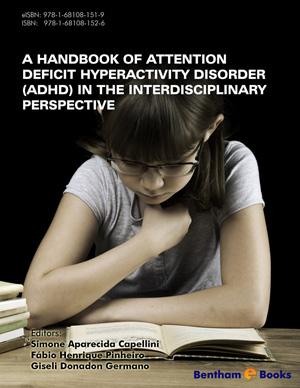Preface
Page: ii-iii (2)
Author: Lawrence T. Lam, ShiJie Zhou and GuoBin Wan
DOI: 10.2174/9781608051861110010100ii
Contributors
Page: iv-v (2)
Author: Lawrence T. Lam, ShiJie Zhou and GuoBin Wan
DOI: 10.2174/9781608051861110010100iv
Abstract
Full text available
The Child Behaviour Scale Chinese (CBSC) - A Validation Study
Page: 1-9 (9)
Author: Guo-Bin Wan and Lawrence T. Lam
DOI: 10.2174/978160805186111001010001
PDF Price: $15
Abstract
The Child Behaviour Checklist (CBCL), developed based on the conceptual framework of child developmental psychopathology proposed by Achenbach, has been considered as the most studied instrument in assessing child behavioural problems. For younger pre-school age children, a specific CBCL/1.5-5 has also been recently developed. However, this specific form of the CBCL has not been translated into Chinese, and thus not validated as a Chinese version. The Child Behaviour Scales-Chinese (CBSC) has been developed by researchers in China for the purpose of providing a useful behavioural assessment instrument for young pre-school children. Studies were conducted to evaluate the psychometric properties of the CBSC. Results obtained from the Confirmatory Factor Analysis indicated that 46 items were to be retained from the pool of 60 with a seven factor structure. Cronhach’s Alpha values for both sexes and total provided evidence for good internal reliability with values ranging from 0.59 to 0.90. Correlations on all subscales between CBSC and CBCL suggested moderate to high concordance providing evidence for reasonable convergent validity. The ICC for all subscales and the total between repeated administrations of CBSC within a period of 4-6 weeks were significantly and moderately high ranging from 0.52 to 0.72. These preliminary results suggest that the CBSC is a valid instrument for assessing young pre-school children in China. Studies could be further conducted to provide more evidence on the externalisation and internalisation factors structure on which the design of the instrument has been based.
The Psychometric Analyses of the Internet Behaviour Questionnaire for Adolescents
Page: 10-17 (8)
Author: Shi-Jie Zhou, Zhi-hong Tang and Yang Peng
DOI: 10.2174/978160805186111001010010
PDF Price: $15
Abstract
This study aims to evaluate the psychometric properties of an instrument, the Internet Behaviour Questionnaire for Adolescents, developed specifically for assessing the utility, emotions associated with, and skills and attitudes towards Internet usage. Initial items were generated with a total of 70. These items were related to the assessment of the motives, pleasure and satisfaction, attitudes and skills of Internet usage. The instrument was then administered to a sample of 490 college students in the Yongzhou city for Exploratory Factor Analysis (EFA) and item reduction. Psychometric properties of the reduced scale were then investigated. The reduced scale was then subjected to further Confirmatory Factor Analysis (CFA) with another sample of 606 college students in the Changsha city with test-retest reliability examined. The results obtained from the EFA suggested a 9-factor solution which could be identified as use of the Internet for information seeking, use of the Internet for cyber sexual activities and gaming, use of the Internet for relaxation and entertainment, use of the Internet for cyber relationships, technological mastery, Internet self efficacy, Internet anxiety, and positive evaluation, and negative evaluation. These 9 factors could explain about 52% of the total variance. Cronbach’s alpha coefficients of the 9 factors ranged from 0.404 to 0.833, and the test-retest correlation coefficients ranged from 0.496 to 0.726. Results obtained from CFA indicated a good fit of a 9-factor structure to the data collected from the confirmatory sample. In conclusion, the Internet Behaviour Questionnaire for Adolescents is a valid and reliable assessment tool for measuring Internet behaviours among adolescents.
The Development of the Zi’s Negative Perfectionism Scale (ZNPS) Fei Zi
Page: 18-26 (9)
Author: Fei Zi
DOI: 10.2174/978160805186111001010018
PDF Price: $15
Abstract
The aim of the study was to develop a questionnaire that measures negative perfectionism. Initial items of the questionnaire were compiled based on a theoretical framework and interviews with experts. An experimental sample of 411 college students was recruited to respond to the initial questionnaire. Exploratory Factor Analysis (EFA) was used to examine the factor structure and the final items set of each factor. A test sample of 427 college students was also recruited for further validation of the questionnaire including test-retest reliability and convergent validity. The results of the EFA indicated a 5-factor structure labelled as Procrastination, Fear of failure, Over conscious, Over planning or control, Overly high standards. The model could explain nearly 50% of the total variance of the data. The Cronbach’s alpha values for these factors ranged from 0.75 to 0.82 suggesting satisfactory internal consistency. The test-retest reliabilities also ranged from 0.61 to 0.81 with a two-week retest interval. Inter-instrumental correlations between the ZNPQ and the Frost Multidimensional Perfectionism Scale (FMPS) suggested reasonable convergent validity. These results provided satisfactory psychometric evidence for the negative perfectionism questionnaire to be used in clinical settings.
The Development of the Zi’s Positive Perfectionism Scale (ZPPS) Fei Zi
Page: 27-33 (7)
Author: Fei Zi
DOI: 10.2174/978160805186111001010027
PDF Price: $15
Abstract
The aim of the study was to develop a questionnaire that measures positive perfectionism. Initial items of the questionnaire were compiled based on a theoretical framework and interviews with experts. An experimental sample of 407 college students was recruited to respond to the initial questionnaire. Exploratory Factor Analysis (EFA) was used to examine the factor structure and the final items set of each factor. A test sample of 309 college students was also recruited for further validation of the questionnaire including test-retest reliability and convergent validity. The results of the EFA indicated a 3-factor structure labelled as Positive Self- Expectations (PSEX), Positive Organization (POR), and Positive Self-Evaluations (PSEV). The model could explain 50% of the total variance of the data. The Cronbach’s alpha values for these factors were 0.87, 0.76, and 0.79 respectively suggesting satisfactory internal consistency. The test-retest reliabilities were 0.79, 0.84, and 0.81 with a two-week retest interval. A Confirmatory Factor Analysis (CFA) further indicated that the 3-factor model fits well with the data (χ2/df =1.71, GFI=.89, CFI=.92, RMSEA =.048). Inter-instrumental correlations between anxiety, depression, and the ZPPQ suggested reasonable convergent validity. These results provided satisfactory psychometric evidence for the positive perfectionism questionnaire to be used in clinical settings.
The City Worker Mental Health Scale: A Validation Study
Page: 34-44 (11)
Author: Li-Fang Deng
DOI: 10.2174/978160805186111001010034
PDF Price: $15
Abstract
The aim of the study was to develop the City Worker Mental Health Scale (CWMHS) and to investigate the psychometric properties of the instrument. This instrument was developed as a self-reported assessment tool. The development was based on a mixture of theoretical and empirical approaches. The psychometric properties of the instrument were investigated with an experimental sample of more than 1000 white-collar workers for its construct validity and factorial structure. A test sample of 1264 participants was also used to test for its internal consistency and test-retest reliability. The convergent validity of the CWMHS was examined using a separate sample of 86 subjects with SCL-90 as the standard. Results on Confirmatory Factor Analysis suggested that a model of a 8-factor structure fitted well with the data. Further analyses indicated that a 5 sub-scale structure was nested in two factors. Cronbach’s alpha coefficients for these factors, ranging from 0.703 to 0.893, also suggested satisfactory internal consistency. Test-retest reliability was also examined yielding high Intraclass correlations ranging from 0.505 to 0.784. Correlations between CWMHS and the SCL-90 provided evidence for satisfactory convergent validity to the instrument. The CWMHS has been demonstrated as a valid instrument suitable for assessing the mental health status of white-collar workers from an Asian background.
The Chinese Workplace Bullying Scale (CWBS) - The Structure and Validation
Page: 45-54 (10)
Author: Yong Xin Li, Guang Hui Nie, Yi Min Li, Ming Hui Wang and Guo Xiang Zhao
DOI: 10.2174/978160805186111001010045
PDF Price: $15
Abstract
The study aims to investigate the structure of a Workplace Bullying Scale developed to measure bullying behaviours in the indigenous Chinese work place context. The Scale was developed using standard methods for instrument design involving literature review, interview, pilot study and survey. Based on the literature, interview and pilot study, items for the Chinese Workplace Bullying Scale were developed. Items were generated through open-ended and structure interviews with 127 interviewees who worked in different enterprises. The preliminary CWBS was then designed and data were collected from an experimental sample consisted of 229 employees of different companies from various regions in China. Exploratory Factor analysis (EFA) was applied to investigate the factorial structure of the CWBS using data collected from the test sample. The factorial validity was further confirmed with Confirmatory Factor Analysis (CFA) using a test sample of 207 workers. Results of the CFA indicated a three-factor structure of the CWBS including personal attack, attack through work tasks, and social exclusion. Further studies were conducted to examine the reliability and validity of the scale. Cronhach’s alpha values provided evidence for good internal reliability with values ranging from 0.71 to 0.85. The predictive power of the CWBS was also demonstrated using hierarchical regression analyses.
Marital Pressure Scale for Chinese City Inhabitants: Development, Reliability and Validity
Page: 55-60 (6)
Author: Yong-Xin Li and Rui-Xia Wu
DOI: 10.2174/978160805186111001010055
PDF Price: $15
Abstract
This study aims to develop an assessment instrument for measuring marital pressure among city inhabitants that is suitable for Asians from a Chinese cultural background. The design of the Martial Pressure Scale was conceptually based on the Pines Couple Burnout model with items initially generated from open-ended questions. Information was gathered from the open-ended questionnaire via personal interviews with a small sample of 10 married couples. Data were then analysed and an initial pool of items was generated. These items were then assessed by a panel of experts that resulted in a 30-item scale. The initial scale was administered to an experimental sample of 260 married adults and data were analysed using Exploratory Factor Analysis. Based on the results of the Exploratory Factor Analysis, the scale was then reduced and modified. Psychometric properties of the reduced scale were then investigated. The reduced scale was subjected to further Confirmatory Factor Analysis (CFA) using a test sample of 800 married individuals. The results obtained from the Factor Analyses suggested a 14-item scale with 3 main components. Internal consistency was obtained for the total, component and item scores with Cronbach’s alpha values ranging from 0.75 to 0.82 and split-half coefficients between 0.71 and 0.80. The results from CFA indicated a 3-component model fitted well with the data and supported the theoretical proposition. In conclusion, the Marital Pressure Scale is a valid and reliable instrument for measuring marital pressure among Asian married individuals from a Chinese cultural background.
The Chinese Marital Quality Inventory: Development, Reliability and Validity
Page: 61-70 (10)
Author: Zao-Huo Cheng, Lin-Xiang Tan, Ying Yang, Xiao-Hong Lin, Dai Zhou, Xioajuan Jiang, Yan-Hua Su, Yong Zhao and Xi-Lin Yuchi
DOI: 10.2174/978160805186111001010061
PDF Price: $15
Abstract
This study aims to develop the Chinese Marital Quality Inventory (CMQI) and to examine its psychometric properties including reliability and validity. This self-reported instrument was developed based on the conceptual framework of previous overseas work as well as similar instruments developed in China. The psychometric properties of the 90 item instrument were examined with an initial sample of 1303 participants for its construct validity and factorial structure, internal consistency, and split-half reliability. Test-retest reliability was examined using a separate sample of 52 subjects and convergent validity was also investigated using Olson’s Family Inventory (OFI), the SCL-90, and the MMPI with another sample of 95 subjects. Results on Exploratory Factor Analysis suggested that a model of a 10-factor structure fitted well with the data with intercorrelations among factors ranging from 0.502 to 0.745. Cronbach’s alpha coefficients for these factors, ranging from 0.462 to 0.645, also suggested satisfactory internal consistency. Split-half correlations also indicated reasonably high splithalf reliability with coefficients between 0.477 and 0.698. Results on test-retest reliability checks yielded good concordance between times with correlations ranging from 0.726 to 0.879. Correlations between CMQI and the OFI provided evidence for satisfactory convergent validity to the instrument with coefficients ranging from 0.124 to 0.799. The total score of the CMQI was significantly correlated with SCL-90 and MMPI. The marital quality of the separated and divorced participants was significantly lower than those who were still married. The CMQI is a validated instrument suitable for assessing the marital quality of adults of an Asian background.
Development, Reliability and Validity of the Chinese Cognitive Ability Scale (CCAS)
Page: 71-81 (11)
Author: Zao-Huo Cheng, Jin-Rong Sun, Bixiu Yang, Xiaojuan Jiang, Xiaoqin Zhou and Li Li
DOI: 10.2174/978160805186111001010071
PDF Price: $15
Abstract
The object of the study was to develop a Cognitive Ability Scale for assessing the cognitive abilities among Chinese people and to examine the psychometric properties, including reliability and validity, of the instrument. The design of the scale was based on in-depth literature reviews and analysis of the contemporary theories of intelligence, and empirical and clinical experience. The psychometric properties of the instrument were evaluated using different samples. Cronbach’s alpha values were large for all sub-scales and for both children and adults. The values ranged from 0.754 to 0.923 for children and from 0.747 to 0.941 for adults with the full test attaining 0.965 and 0.967 for children and adults respectively. Split-half reliability values were also large for all sub-scales for all ages ranging from 0.810 to 0.928 for children and from 0.829 to 0.948 for adults yielding a satisfactory overall internal consistency for the test. The convergent validity of the CAAS for adults and children was evaluated using the WAIS-CR and WISC-CR. The results on inter-instrumental correlations between CAAS and WISC-RC showed many variations in the correlation coefficients among the sub-scales of the two measures. The correlations ranged from a very weak correlation of 0.09 to a high correlation of 0.87. The CCAS has been demonstrated as a valid and reliable instrument for assessing dementia among elderly people from a Chinese speaking background.
Development, Reliability and Validity of Dementia Screening Inventory for Elderly
Page: 82-92 (11)
Author: Zao-Huo Cheng, De-Liang Cai, Da Li, Liang Liu, Hai-Yan Yu and Ping Li
DOI: 10.2174/978160805186111001010082
PDF Price: $15
Abstract
The object of the study was to develop a Dementia Screening Inventory for the Elderly (DSI-E) and to examine the psychometric properties, including reliability and validity, of the instrument. The screening inventory, designed to assess cognitive abilities, daily activities, and mental and personality changes for the elderly, was modelled after the Mini Mental State Examination (MMSE) and the Bristol Activities of Daily Living Scale (ADL). The psychometric properties of the instrument were evaluated using a sample of 2815 communitydwelling elderly participants with retesting on 215. One hundred and nineteen were also administrated with MMSE, ADL, the Memory Assessment Scale (MAS), and the Cognitive Assessment Scale for the Elderly (CASE) for convergent validity examination. Results from the Confirmatory Factor Analysis (CFA) suggested that the 55- item scale with 11 subscales fitted best to the data with a 3-factor model that explained 60.1% of the total variance. Internal consistency and split-half reliability were confirmed with high Cronbach’s alpha values ranging from 0.48 to 0.91. The DSI-E was significantly correlated with MMSE (r=0.92), ADL (r=0.89), MAS (r=0.71), and CASE (r=0.63) with a test-retest reliability ranging from 0.72 to 0.99. The DSI-E has been demonstrated as a valid and reliable instrument for assessing dementia among elderly people from a Chinese speaking background.
Index
Page: 93-95 (3)
Author: Lawrence T. Lam, ShiJie Zhou and GuoBin Wan
DOI: 10.2174/978160805186111001010093
Abstract
Full text available
Introduction
This book presents a collection of psychological and health-related assessment tools designed and developed in China. These instruments are formulated with a specific focus on their applicability and cultural appropriateness to Chinese people living in China or overseas as well as other Asians who may share a Chinese cultural heritage. The methods and procedures on item and scale formation are described in detail with respect to their relevant cultural background and underpinning beliefs. Results on psychometric properties and validation are thoroughly presented. Each instrument is included with an English Translation.












